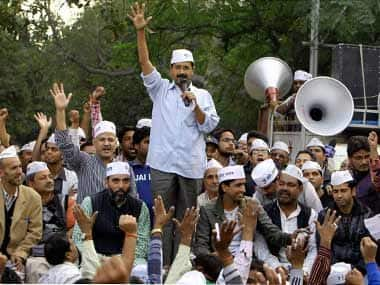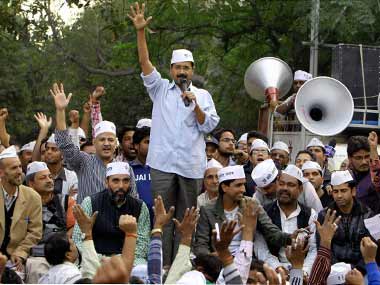Tomorrow Delhi goes to polls and today you need to realise how well the Aam Aadmi Party has done in crafting its strategy in its first ever bid to get its candidates elected. Apart from Arvind Kejriwal, it has no star power. Not even a known politician who is a known face enough to pull the crowds in a mohalla. AAP may win the polls to form a government replacing Sheila Dikshit’s rule. Then again, it may not win enough to get anywhere there. One accepts that toss up.The key intent, it appears to me, is at least to ensure that if a government has to be formed, either of the two parties – BJP or the Congress – would need to tie up with AAP. This kind of a tie-up, it has been said loudly and clearly, is not on the table. It is either them or no one at all. [caption id=“attachment_1263603” align=“alignleft” width=“380”]  Kejriwal has at least shown us that an alternative way of politics is possible: PTI[/caption] That stand exemplifies the virtue of the power of disruptive politics. It would actually, be a shot in the arm for those seeking to redefine politics increasingly dominated by the rich and powerful, most of them who owe their wealth to politics in any case. Arvind Kejriwal has rightly said “it is not the Aam Aadmi Party but the people who are fighting this election”, making the voter a constructive partner in developing a new order.But there are risks built into this design and AAP will make a virtue out of it. If neither of the two, Congress or the BJP, can form the government, and AAP remains resolute on its stand, the state can face either a repoll or the prospect of President’s rule for a while. In essence, the message would be: you need the aam aadmi to form a government. Should this happen, the city-state’s aam aadmi could well get frustrated, which could drive them to vote overwhelmingly either way in subsequent rounds of voting; That is keep AAP out or get AAP into the saddle all on its own. One presumes AAP has involved the voters enough, to ensure that they will not be frustrated should it not form a government. That it chose Delhi for its initial foray – Kejriwal insists it is a start for the idea is to clean up India’s politics – has a meaning. It is a compact state as states go. It has only 70 seats to contest, and campaigning logistics would be relatively easier than in any of the other four states which are also poll bound. Management officials will find parallels between this AAP venture and the test marketing of a product they conduct while in evolution. During such phases, small samples of potential buyers are exposed to the brand to see if it is accepted or not. It is done using actual stores, simulating a larger market. This allows product manufacturers to gauge consumer reaction, including whether the product has any use at all. It is, however, a high cost practice lasting several months or even years. Final choices on product design, its pricing, and its unique selling points (USPs) are determined thereafter. That is what is happening now. The density of voters in crowded cities make for small geographies. Getting around costs less in terms of time and money; logistics are easier handled. AAP volunteers are unpaid, and can even use public transport to go to help any of their candidates. Delhi has been its battle ground right from the time the constituents of the party were involved in the anti-corruption, pro-Jan Lokpal campaign with Anna Hazare. An informal networking had been possible. Furthermore, given that Delhi is home to most TV news channels, 24x7 beaming of their doings was also possible. By that, and the very fact that they were taking on a 15-year rule of a single politician leading a single party, made it an immediate David and Goliath enterprise which was guaranteed to win the hearts of ordinary persons who are in awe of the powerful but dislike their ways. Delhi becomes, thus, a propaganda node. If any of the other states – Rajasthan, Chhattisgarh, Madhya Pradesh or Mizoram – had been chosen as the place of debut, the TV stations would not have given the party even cursory reportage. Thus, in myriad ways, Delhi has been a nicely chosen showcase for the Aam Aadmi Party so that the rest of the country gets to see what it is up to and who is it fighting against. In making it a triangular fight to the extent that smaller parties like JDU, SAD, BSP and suchlike do not even find mention in the current discourse on Delhi polls, shows how successful AAP has been in its purpose. The present, even euphoria-laden ‘can-do’, success of the campaign can translate into a belief that alternate politics is actually doable. The volunteers from across India who have gained experience and find resonance from the voters for their enthusiasm, can easily become AAP’s ambassadors in other states. However, the worst enemy the AAP can find is people like us who vent ire and grief but do not walk to the polling booths. Voter apathy, especially in urban areas except where the poor live, is legendary and Delhi is by and large an urban state. They had craved for NOTA – none of the above option – and it is now available. But so is AAP.
However, the worst enemy the AAP can find is people like us who vent ire and grief but do not walk to the polling booths
Advertisement
End of Article
Written by Mahesh Vijapurkar
Mahesh Vijapurkar likes to take a worm’s eye-view of issues – that is, from the common man’s perspective. He was a journalist with The Indian Express and then The Hindu and now potters around with human development and urban issues. see more


)
)
)
)
)
)
)
)
)



